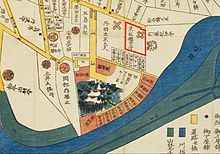Kyōgoku (clan)
The Kyōgoku ( Japanese 京 極 氏 , Kyōgoku-shi ) were a branched family of the Japanese sword nobility ( Buke ), which was derived from the Uda-Genji via Sasaki Ujinobu . With an income of 50,000 Koku , the Kyōgoku residing in Marugame ( Ehime Prefecture ) belonged to the medium-sized Tozama daimyo of the Edo period .
The clan is not related to the family of poets and politicians going back to Fujiwara no Tameie and Kyōgoku Tamekane .
genealogy
- Takayoshi ( 高 吉 ; 1504–1581) had two sons, Takatsugu and Takatomo.
-
Takatsugu ( 高 次 ; 1560–1609), Takayoshi's son, founded the main branch. He served Oda Nobunaga , who married him to his niece, daughter of Asai Nagamasa and sister of Yodogimi. Toyotomi Hideyoshi , his brother-in-law, gave him the domain of Ōtsu ( Ōmi province ) with 60,000 koku. Takatsugu then joined Tokugawa Ieyasu , whereupon he was trapped in his castle by Tachibana Muneshige and Tsukushi Hirokado. But he was able to achieve free withdrawal through negotiations and fled to the mountain monastery Kōya-san . Nevertheless, in the same year, namely in 1600, he received the domain from Obama ( Wakasa ) with 92,000 koku. At the urging of his mother and brother Takatomo, he was baptized with his entire family in 1602.
-
Tadataka ( 忠 高 ; 1593-1637), Takatsugu's son, married in 1607 the fourth daughter of the Shogun Tokugawa Hidetada . He participated in the siege of Osaka in 1615 and took home more than 300 heads as trophies. In 1634 his income was increased when he received matsue ( Izumo ) with 260,000 koku. Tadataka died three years later with no offspring. The shogunate then installed his nephew Takakazu, who received Tatsuno (Harima Province) with 50,000 koku. In 1658 the family was transferred to Marugame ( Sanuki ), where they resided until 1868. The last daimyo was
- Asayuki ( 朗徹 ; 1828–1882), after 1868 vice count .
- A side branch resided from 1694 to 1868 in a permanent house ( jinya ) in Tadotsu (Sanuki) with 10,000 koku. After 1868 Vice Count.
-
Tadataka ( 忠 高 ; 1593-1637), Takatsugu's son, married in 1607 the fourth daughter of the Shogun Tokugawa Hidetada . He participated in the siege of Osaka in 1615 and took home more than 300 heads as trophies. In 1634 his income was increased when he received matsue ( Izumo ) with 260,000 koku. Tadataka died three years later with no offspring. The shogunate then installed his nephew Takakazu, who received Tatsuno (Harima Province) with 50,000 koku. In 1658 the family was transferred to Marugame ( Sanuki ), where they resided until 1868. The last daimyo was
-
Takatomo ( 高 知 ; 1571-1621) served Hideyoshi and received Iida ( Shinano ) with 80,000 koku in 1592 . Then he joined Ieyasu and besieged Gifu Castle ( Mino ). After 1600 he received Tanabe ( Tango ) with 125,000 koku and built a castle , shortly after that he built Miyazu Castle and settled there. He took part in the two sieges of Osaka in 1614 and 1615. Takatomo was baptized and was given the name John.
-
Takahiro ( 高 広 ; 1599–1677), Takatomo's son and heir, took over the domain after his death with an income reduced to 75,000 koku. Because of poor administration, he and his son Takakuni (1616–1675) were deposed in 1666 by Shogun Tokugawa Ietsuna . Takakuni had to go into exile in Nambu, Takahiro shaved his head and came under house arrest in Okasaki near Kyoto.
- Takayori ( 高 頼 ), Takakuni's son, was exiled to Tsu when his father went into exile in 1666. In 1687 Takayori was pardoned and received as a Kōke ( 高家 ) a pension of 2000 Koku.
- Another son of Takatomo, Takamitsu , founded a branch that resided in Tanabe (Tango) from 1604 and then from 1688 to 1868 in Toyooka ( Tajima ) in a permanent house with 15,000 Koku. After 1868 Vice Count.
- Takamichi ( 高 道 ; 1603-1665), a son of Kuchiki Tanetsuna, who had been adopted by Takatomo, founded a branch that resided in Mineyama (Tango) from 1620 until 1868. After 1868 Vice Count.
-
Takahiro ( 高 広 ; 1599–1677), Takatomo's son and heir, took over the domain after his death with an income reduced to 75,000 koku. Because of poor administration, he and his son Takakuni (1616–1675) were deposed in 1666 by Shogun Tokugawa Ietsuna . Takakuni had to go into exile in Nambu, Takahiro shaved his head and came under house arrest in Okasaki near Kyoto.
Remarks
- ↑ On the left, a Kompira shrine adjoins the residence: in memory of the Kompira at home.
- ↑ Today the district of Maizuru .
- ↑ Today part of Kyōtango .
Individual evidence
- ↑ Miura, Masayuki (ed.): Shiro to jinya. Saikoku-hen. Gakken, 2006. ISBN 978-4-05-604379-2 . S.
- ↑ Excerpt from the district map "Shibaguchi-minami" from approx. 1850.
literature
- Edmond Papinot: Historical and Geographical Dictionary of Japan. Reprint of the 1910 edition. Tuttle, 1972, ISBN 0-8048-0996-8 .
- Miura, Masayuki (Ed.): Shiro to jinya. Saikoku-hen. Gakken, 2006. ISBN 978-4-05-604379-2 .
- Miyaji, Saichiro (Ed.): Bakumatsu shoshu saigo-no hanshu-tachi. Nishinihon-hen. Jinbunsha, 1997. ISBN 978-4-7959-1906-8 .




